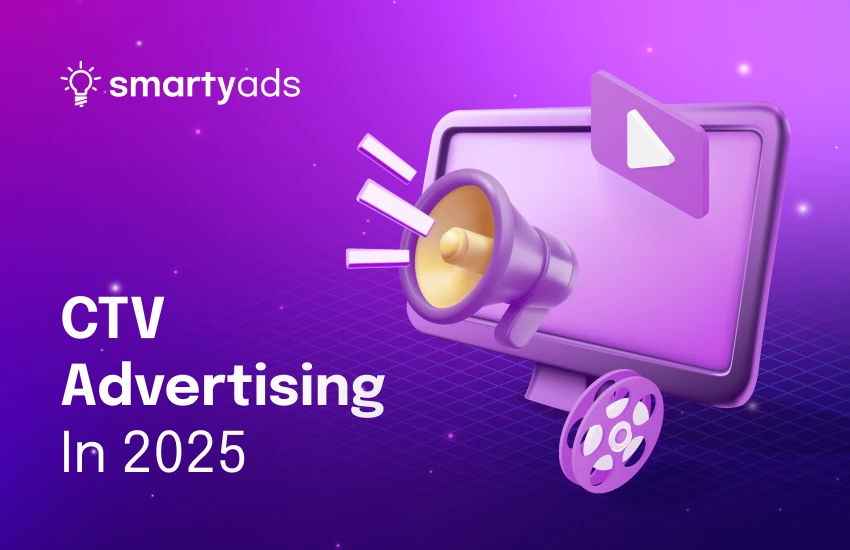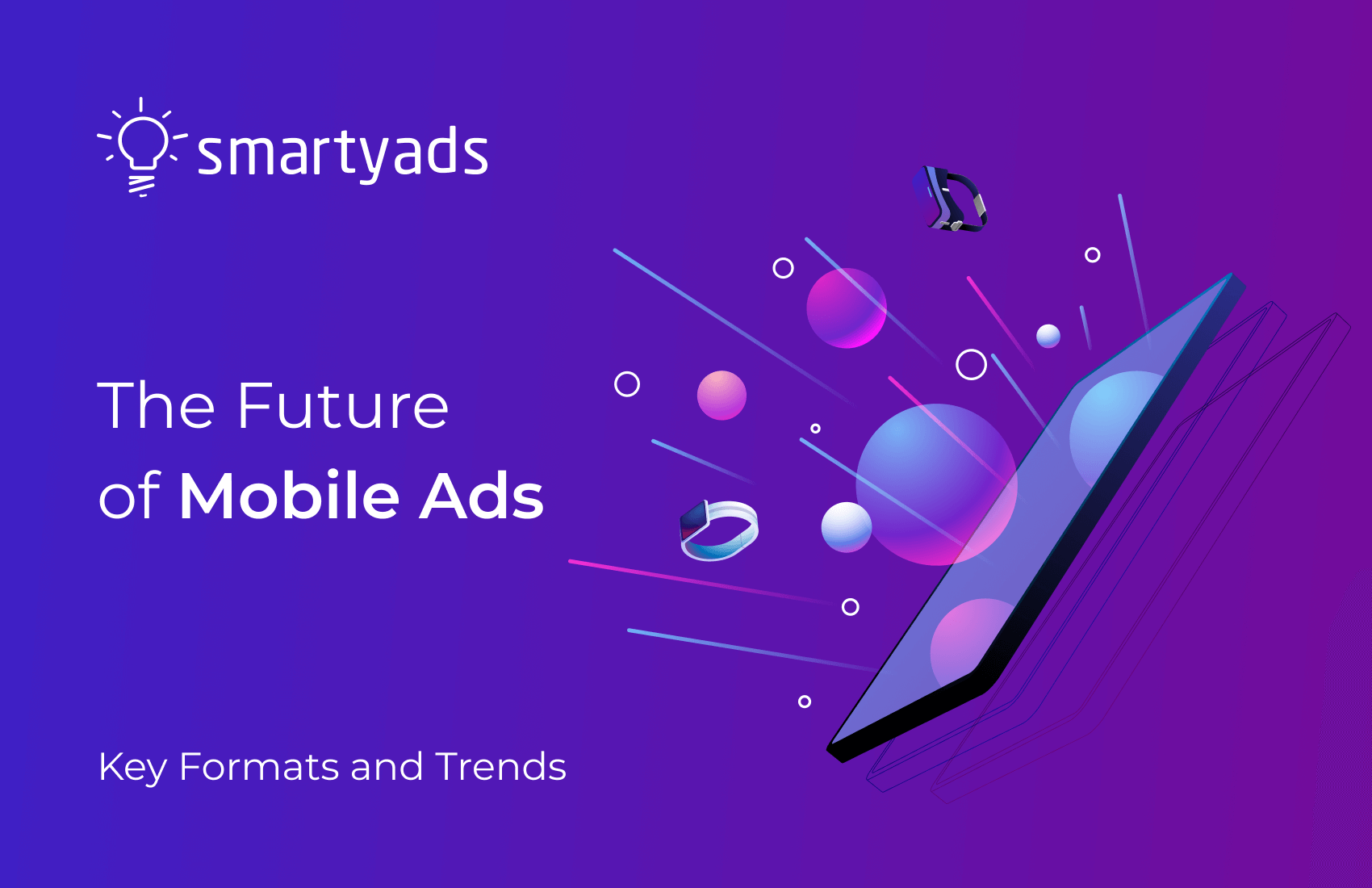Video ads have become the heartbeat of digital marketing. They don’t just grab attention — they hold it. In a feed full of noise, motion still wins. A short, emotional video can tell your story faster than a thousand words ever could.
Today, brands compete not only with each other but with seconds of user attention. That’s why the tools behind your campaign matter as much as the creative itself. Choosing the right video DSP can be the difference between an ad that’s simply seen — and one that actually sells.
In this article, we’ll compare the top video demand-side platforms, explore their strongest sides, and share strategies that help advertisers get the most out of every impression.

What is a video DSP platform and why it matters in 2025
Video advertising isn’t slowing down — it’s scaling faster than ever. 2025 is the year when programmatic becomes the rule, not the option. Brands that adapt to smarter buying tools now will own the attention later. The numbers speak louder than words:
- In 2025, programmatic will account for nearly 9 in 10 digital display ad dollars globally (eMarketer).
- Digital ad spending will make up over 75 % of total media ad spend worldwide (eMarketer).
- In the U.S., digital video ad spend is expected to reach $72 billion in 2025 — growing about 18 % year over year (IAB).
- Globally, video ad spending is projected to hit $207.5 billion (Statista via HubSpot).
- Around 73 % of all ad revenues will come from digital channels (MAGNA).
It’s clear — video is not just a format anymore. It’s the pulse of digital advertising. And the Video DSP is the brain that keeps it beating in rhythm — connecting data, targeting, and creativity in one place.
Definition of video demand-side platform
A video demand-side platform (DSP) is like a control room for your video ads. It’s where you plan, buy, and manage video campaigns across different channels — web, mobile, CTV, and OTT — all in one place.
Instead of manually negotiating with publishers, the DSP does the hard work for you. It uses data, algorithms, and real-time bidding to show your ad to the right person, at the right time, and on the right screen.
In simple words — it’s your smart assistant in the world of video advertising. It saves time, cuts guesswork, and helps every dollar work a little harder. Read more about what is a DSP and how to use it.
Key differences between video DSP and traditional DSP
A traditional DSP is like a multitool — it works with banners, native ads, display formats. A video DSP, on the other hand, is a specialist. It’s built for motion, sound, and storytelling.
While regular DSPs focus on clicks and impressions, DSP for video advertising goes deeper — they measure view time, engagement, and how people feel when they watch your ad.
Think of it like the difference between a photo and a short film. Both can tell a story, but only one moves, breathes, and truly captures attention.
Evolution: from desktop to CTV, OTT, mobile
Video DSPs have come a long way. What started with simple desktop pre-rolls has turned into a cross-screen universe where every moment matters.
Today, people stream shows on their TVs, scroll videos on their phones, and switch between devices without thinking twice. The best Video DSPs follow that rhythm — adapting to every screen and keeping the story seamless.
It’s like your campaign has learned to travel — from laptop to living room, from browser to smart TV — meeting your audience wherever they are, without missing a beat.
5 Best video DSP platforms in 2025
The market for video DSP technology in 2025 is more competitive than ever. Each platform promises smarter automation, better targeting, and stronger cross-screen performance. Below, we’ve highlighted five leading players that stand out for their innovation, transparency, and results.
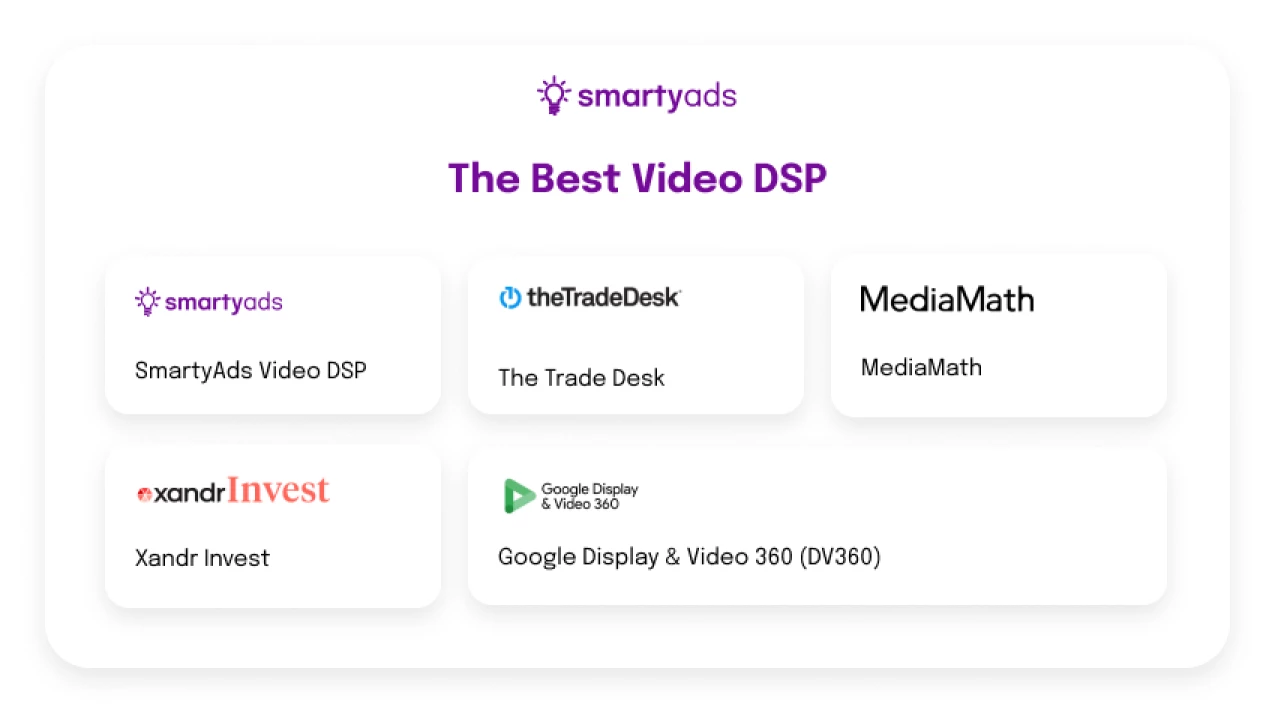
SmartyAds Video DSP
A full-stack programmatic platform known for its cross-channel reach and intuitive creative tools. SmartyAds DSP lets advertisers design, launch, and optimize video campaigns in minutes — no third-party integrations needed. With strong analytics, real-time bidding, and built-in Creative Builder, it helps brands scale globally while keeping control over every impression.
The Trade Desk
One of the most recognized names in programmatic, The Trade Desk offers vast inventory access and detailed audience insights. It’s ideal for brands seeking global scale and advanced measurement tools, though pricing can lean toward enterprise-level budgets.
Google Display & Video 360 (DV360)
DV360 remains a go-to choice for advertisers already in the Google ecosystem. It combines YouTube inventory with premium publisher access and detailed targeting capabilities. However, it’s often less flexible for independent agencies or smaller teams.
MediaMath
A long-time programmatic player focused on transparency and data-driven optimization. MediaMath supports strong omnichannel campaigns and provides in-depth analytics, though its interface can feel complex for beginners.
Xandr Invest
Xandr brings together premium video inventory and audience targeting within a single platform. It’s known for quality supply, especially in CTV and OTT, and for offering flexible deal options for buyers who value scale and control.
Comparison table
Video DSP advertising strategies for 2025
Video advertising is no longer about simply running an ad — it’s about how you run it. The right strategy can turn a short clip into a brand memory, while the wrong one gets lost in the scroll. Below are five key approaches that help video campaigns shine brighter in 2025.
Choosing the right video formats
Every story needs the right stage. The same goes for video ads — the format you choose decides how your message feels and how well it performs.
Short in-stream videos grab quick attention, while longer mid-rolls help build emotion and depth. Out-stream formats work best when you want to reach users beyond traditional video players — in feeds, articles, or apps.
The trick is to match the format to the moment. Think of it like tailoring a suit — one size never fits all.
Creative best practices: length, aspect ratio, storytelling
Good video ads don’t shout — they connect. The first few seconds decide everything, so start strong. Show movement, emotion, or a clear hook right away.
Keep it short and focused — 6 to 15 seconds is often enough to spark interest without losing attention. Use the right aspect ratio for each screen: vertical for mobile, horizontal for CTV.
And most importantly — tell a story. Even in a few seconds, give people something to feel. A smile, curiosity, recognition — that’s what makes an ad stay in their mind after the screen goes dark.
Leveraging data and audience segmentation
Behind every great video ad, there’s data quietly doing its job. It helps you see who is watching, when they tune in, and what makes them stay.
Segmentation is where the magic happens. Break your audience into smaller stories — new customers, loyal fans, curious visitors — and speak to each one differently.
It’s like tuning a radio: when the frequency is right, your message comes through clear and personal.
Optimizing for viewability and completion rate
It doesn’t matter how beautiful your ad is if no one really sees it. Viewability is your first test — making sure your video appears in the spotlight, not the shadows of the screen.
Then comes the real challenge — keeping people watching. Use pacing, music, and visuals that flow naturally. Don’t force it — guide their attention like a story unfolding frame by frame.
When done right, viewers don’t just see your ad — they stay with it till the very last second.
Integrating AI and automation in video buying
AI has become the quiet strategist behind the scenes. It studies patterns, learns from performance, and makes smarter bidding decisions faster than any human could.
Automation takes the heavy lifting off your hands — adjusting budgets, testing creatives, and finding the right audience in real time.
Think of it as having a co-pilot who never sleeps. You set the direction, AI fine-tunes the route — making sure every impression works a little harder for your campaign.
SmartyAds Video DSP: Key Features & Benefits in 2025
In 2025, advertisers need more than just reach — they need precision, speed, and results they can measure. That’s where SmartyAds Video DSP comes in. It turns complex programmatic processes into a smooth, data-driven flow that feels effortless.
Key benefits:
- Advanced targeting — reach the right audience across CTV, mobile, and web in one platform.
- Real-time optimization — AI adjusts bids and placements instantly to boost performance.
- Creative flexibility — build and test video ads directly with Creative Builder.
- Cross-screen reach — deliver consistent storytelling across every device and format.
- Transparent analytics — track KPIs, viewability, and ROI with clear, easy-to-read reports.
With these tools, you don’t just run ads — you run smarter campaigns that grow with every impression.
Now, let’s see how to set up a campaign step by step.
Set up a video ad campaign: step-by-step
We'll break the process into six steps to help you understand how to use the DSP platform and get the best results from the video ads.
Step 1: Creative video digital advertising
Think about how you'd like to make a digital video ad for a potential client. That could be a funny, short, but memorable video. Or a riveting story? Or will you immerse the customer in your busy and successful world so they can trust you?
Consider how you would like to complete a video message in a dynamic format to a potential client. For example, you can look at the latest trends in digital video advertising.

Step 2: Consider the video length and whether it is skippable
Think about the exact place and length of your creative video. In terms of the interactivity of advertising, there are video types: skippable ads and non-skippable ads, playing in video content at the start (pre-roll), middle, and end. Each customization aspect will affect how your potential customers perceive your message:
- Skippable ads do not force users to watch the advertisements till the end;
- Non-skippable ads are the perfect tool if you need a quick conversion. You can force a user to look at an ad; sometimes, that's an excellent tactic. People who watched the video till the end are your potential customers.

Step 3: Choose Video Ad Formats
The purpose of video ads is the same as static ads: to reach the right users on the right screen. Videos of different formats can be interactive and non-interactive. Video creative can be full-screen, reflect web content, or be more compact.
To take advantage of video ads, it is essential to learn the most effective mobile/web advertising formats for your strategy. The main video ad formats include:
- In-stream
- Native video
- Video interstitial
- In-banner ads video
- Rewarded video
- Mobile video
- Reveal video
- Playable ads
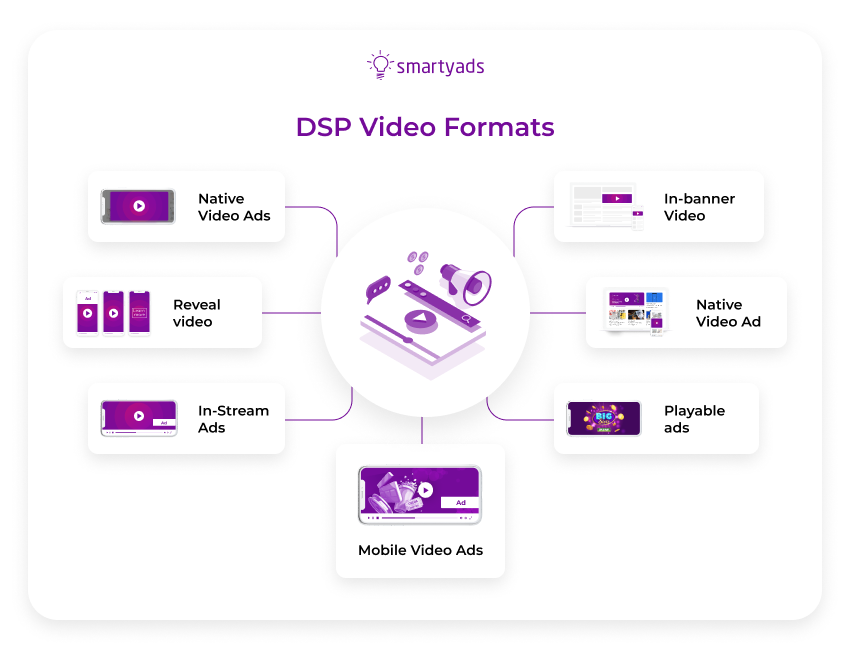
Step 4: Launch your video ad DSP campaign
We will show you how to create and upload your video ad with SmartyAds Demand Side Platform for video. It is a single transparent dashboard with easy navigation, which allows you to manage campaigns in one place.
First, choose a campaign type — video:
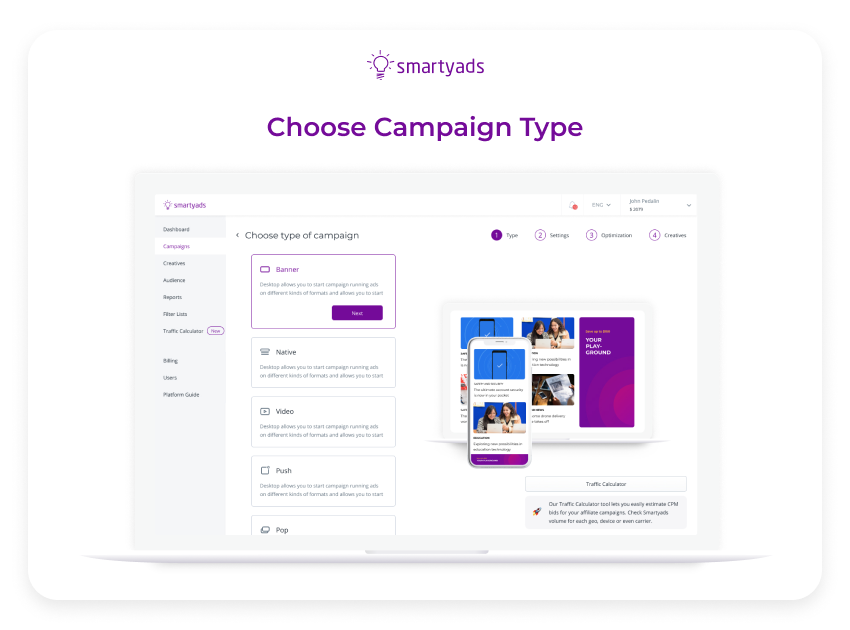
Then fill in the campaign parameters such as targeting options, budget distribution, filters, monitoring, and optimization:
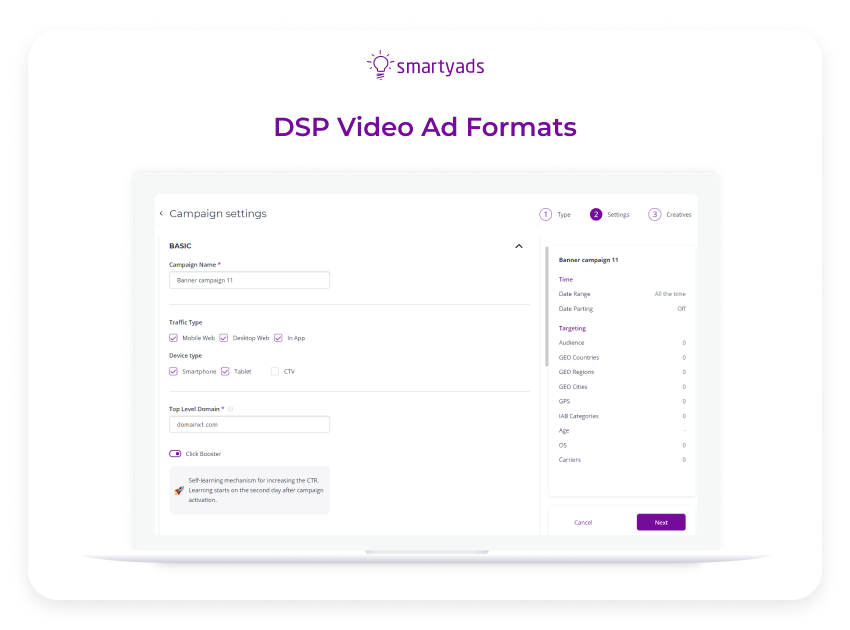
Consider: which audience segments do you need for your video advertising? Who is your ideal customer? For high-quality, sophisticated targeting, you can use demographics, geo, status, age, gender, behavioral habits, and more.
SmartyAds DSP delivers a detailed analysis of what will improve the online advertising strategy. It enables a deeper understanding of all processes, which is valuable for business development.
Step 5: Upload your video ad creative
Choose these parameters: creative name, the price for 1000 impressions, and frequency.
Name. Give a name to your video creative to set it apart from other creatives. As an example, use your product name and start date.
Click URL. Enter the site URL we will direct the user when they click on the ad.
CPM. Select an acceptable price for a thousand impressions.
Frequency. Choose how many times a day the unique user will be able to view such video advertisements (no more than 2-3 times to avoid irritation).
You can see the valid parameters as minimum video bitrate, required duration, or minimum frame size here:
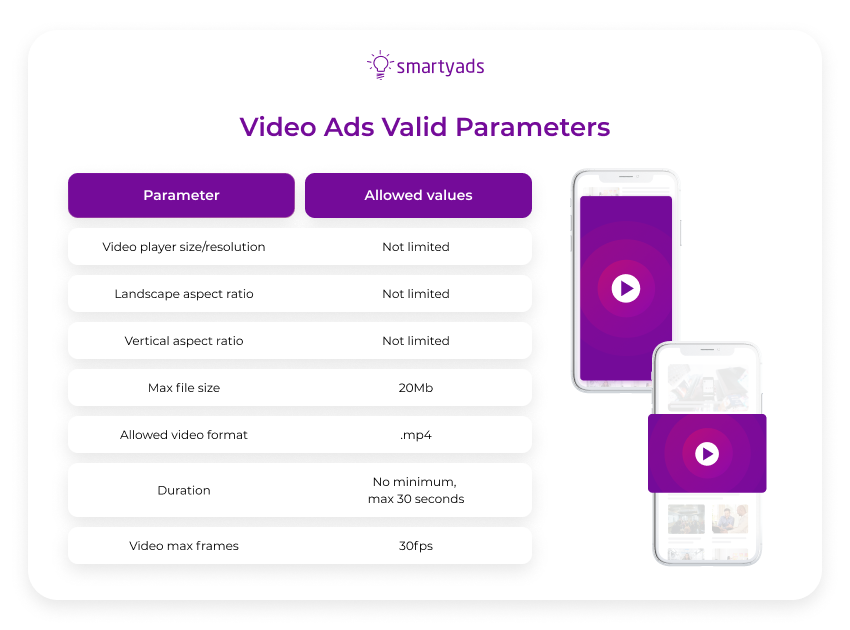
To create video ads, you need a VAST tag in XML format, which is more effective, or a URL.
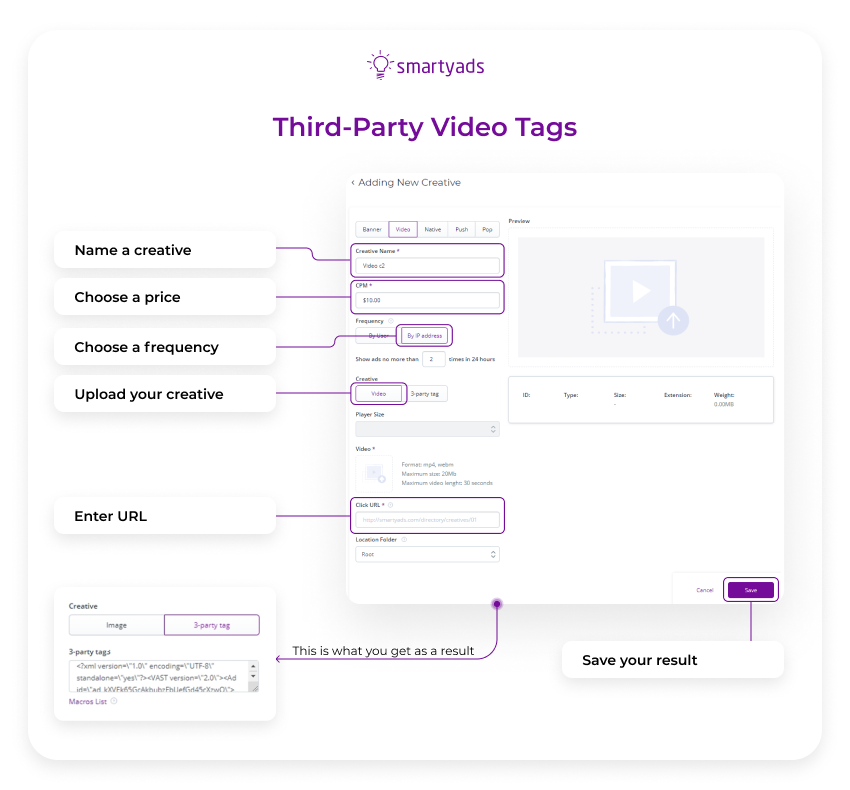
The standard SmartyAds DSP video creative is a file played in front of the video content. It is built into the app or on the site page where video content already exists. Standard video resolutions work better: 300x250, 480x320, 480x360, 640x360, and 720x1280. However, SmartyAds DSP supports non-standard solutions.
Protect your brand
The real-time interaction of Demand Side Platforms with Ad Exchanges is complicated and, therefore, requires fraud protection of traffic. In particular, we use Protected Media and Pixalate to scan ad inventory to place your ads and The Media Trust to verify the quality of video advertisements. Additionally, DSP helps to find publishers with brand-safe content and the best ad exchanges.
Step 6: Boost your video ad campaign with SmartyAds DSP
Now is the time to experiment with programmatic video advertising, and it is best to do it with the SmartyAds platform.
Our DSP offers fascinating features and add-ons based on its SmartyAds technology. You can target video advertisements, track key performance indicators (KPIs) and keep up with your competitors. Optimize your video ads with the SmartyAds DSP to boost your ad campaign performance on the go!
Final thought
Finding the right video DSP isn’t just about features — it’s about having a platform that feels smart, reacts fast, and grows with your goals. The right tech should work quietly in the background while your ads do the talking — reaching the right people, in the right moment, on the right screen.
With SmartyAds DSP, that’s exactly what happens. You get clear targeting, smooth optimization, and tools that make every second of your video ad count.
Ready to see it in action? Start with SmartyAds DSP and turn your video campaigns into stories that perform.

FAQ
The best DSP for video is the one that helps your ads work smarter, not harder. SmartyAds DSP does exactly that — it finds the right audience, adapts in real time, and shows you what really performs. In short, it turns your video ideas into campaigns that actually convert.
Think of a demand-side platform for video ads as a tool built for movement and sound — not static banners. It’s made to handle storytelling through video, track how long people watch, and adapt for CTV, mobile, or web. Regular DSPs can’t always capture that kind of emotion and engagement.
Start simple. Test your creatives, know your audience, and keep tweaking. Video success isn’t magic, it’s rhythm. The more you tune campaigns through data and creative tools, the higher your return climbs. SmartyAds DSP helps you do just that — and keeps every second of your ad time working for you.


